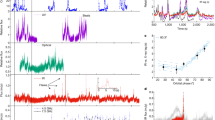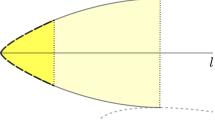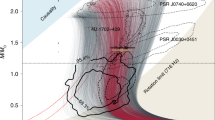Abstract
THE inverse Compton effect has recently received attention as a possible source of the continuous radiation of quasi-stellar objects1–3. Hoyle et al.4 concluded that quasi-stellar objects cannot be at cosmological distances because otherwise the inverse Compton effect would force the electrons to dump their relativistic energies in times so short that no known acceleration mechanism could be responsible for their original appearance. Modifications of this argument have been discussed by several authors5–9, in particular by Woltjer10, who considered a radiation (and electron) flux restricted to a narrow cone about the radial direction.
This is a preview of subscription content, access via your institution
Access options
Subscribe to this journal
Receive 51 print issues and online access
$199.00 per year
only $3.90 per issue
Buy this article
- Purchase on Springer Link
- Instant access to full article PDF
Prices may be subject to local taxes which are calculated during checkout
Similar content being viewed by others
References
Greenstein, J. L., and Schmidt, M., Astrophys. J., 140, 1 (1964).
Ginzburg, V. L., Ozernoi, L. M., and Syrovatsky, S. I., Soviet Phys. Dokl., 9, 683 (1964).
Shklovskii, I. S., Sov. Astro., 9, 683 (1966).
Hoyle, F., Burbidge, G. R., and Sargent, W. L. W., Nature, 209, 751 (1966).
Rees, M. J., Nature, 211, 805 (1966).
Rees, M. J., and Sciama, D. W., Nature, 213, 374 (1967).
Hoyle, F., and Burbidge, G. R., Nature, 212, 1223 (1966).
Hillier, R. R., Nature, 212, 1334 (1966).
Pfleiderer, J., and Grewing, M., Science, 154, 1452 (1966).
Woltjer, L., Astrophys. J., 146, 597 (1966).
Kapitza, P. L., and Dirac, P. A. M., Proc. Cambridge Phil. Soc., 29, 297 (1933).
Felten, J. E., and Morrison, P., Astrophys J., 146, 686 (1966).
Burbidge, G. R., and Burbidge, E. M., in Quasistellar Objects (Freeman and Co., San Francisco, 1967).
Author information
Authors and Affiliations
Rights and permissions
About this article
Cite this article
OSTER, L. New Restriction on Models for Quasistellar Objects. Nature 217, 148–149 (1968). https://doi.org/10.1038/217148a0
Received:
Revised:
Published:
Issue Date:
DOI: https://doi.org/10.1038/217148a0
This article is cited by
-
Omnidirectional induced compton scattering by relativistic electrons
Astrophysics and Space Science (1974)
-
Индуцированное комптоновское рассеяние изотропного излучения релятивистскими электронами
Astrophysics and Space Science (1974)
-
Induced Compton scattering by relativistic particles
Astrophysics and Space Science (1971)
-
Stimulated Inverse Compton Scattering in Radio Sources
Nature (1968)
-
Quasars
Die Naturwissenschaften (1968)
Comments
By submitting a comment you agree to abide by our Terms and Community Guidelines. If you find something abusive or that does not comply with our terms or guidelines please flag it as inappropriate.



